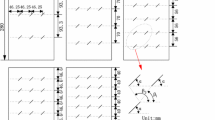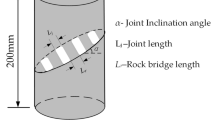Abstract
To study the failure mechanisms of joints and rock bridges in jointed rock masses a series of uniaxial compression tests were performed on specimens made of rock-like material. Specimens of size 63.5 cm × 27.9 cm × 20.3 cm, made of 72% silica sand, 16% cement (Type I) and 12% water by weight were tested. The joint inclination angle was maintained at 45°, while the offset angle i.e. angle between the plane of the joint and the line that connects the two inner tips of the joints, was changed from 0°–120° with an increment of 15°. The tests were performed using a 2000 kN universal compression machine and a HP data acquisition system. In each sample, five LVDTs were fixed to measure the displacements along and across both the bridge and the joint segment, and the total displacement along the total length of the sample. The failure mechanism was monitored by visual inspection and a magnifier to detect cracks initiation. For each test the failure surfaces were investigated to determine the characteristics of each surface. In all of the tested samples curvilinear cracks called wing cracks initiated at the joints tips due to high tensile stresses concentration. These wing cracks were directed along the direction of the uniaxial load. The coalescence mechanism of two cracks was investigated. Results showed that open cracks could coalesce by shear failure or tensile failure. The coalescence path was found to be mainly dependent on the inclination of the rock bridge between the cracks.
Similar content being viewed by others
References
Alzo 'ubi, A.(2001)Fracture mechanisms of open offset rock joints under uniaxial loading, M.Sc.thesis, Jordan University of Science and Technology,Irbid,Jordan.
Barton,N.(1971)A model study of the behavior of steep excavated rock slopes.Ph.d.thesis, University of London,U.K.
Brown, E.T.and Trollop, D.H.(1970)Strength of a model of jointed rock, In:Journal of Soil Mech.&Found.Engrg, Proc.ASCE,Vol.96,pp.685-704.
Deng, Q.and Zhang,P.(1984)Research on the geometry of shear fracture zones,Journal of Geophys.Res.,89, 5669-5710.
Einstein, H.H., Veneziano,D., Baecher, G.B.and O 'Reilly, K.J.(1983)The effect of discon-tinuity persistence on rock stability,Int.J.Rock Mech.Min.Sci.,Geomech.Abstr.,20, 227-237.
Fumagalli,E.(1968)Model simulation of rock mechanics problems.In:K.G. Stagg and O.C. Zienkiewicz (eds.),Rock Mechanics in Engineering Practice, chapter 11,John Wiley and Sons,Inc., London,England,pp.353-984.
Goodman, R.E., Heuze, F.E.and Bureau,G.(1972)On modeling techniques for the study of tunnels in jointed rock,In:Proceedings of the 14th Symposium on Rock Mechanics, Pennsylvania State University, U.S.A.
Griffith, A.A.(1921)The phonomana of rupture and flow in sloids,Philos.Trans.R.Soc. London Ser.A, 21, 163-198.
Heuer, R.E.and Hendron, A.J.(1969)Geomechanical model of the behavior of underground openings in rock subjected to static load,Rep.1,Development of Modeling Techniques, Contract Rep.N-69-1,U.S.Army,Engineer Waterways Experiment Station,Corps of Engineers,Vicksburg,U.S.A.
Jamil, S.M.(1992)Strength of non-persistent rock joints,Ph.d.thesis, University of Illinois at Urbana-Champaign,IL,U.S.A.
Johnston, I.W.and Choi, S.K.(1986)A Synthetic soft rock for laboratory model studies, Geotechnique, 36 (2),251-263.
Ladanyi, B.and Archambault,G.(1980)Direct and indirect determination of shear strength of rock mass,AIME Annual Meeting,Las Vegas.Preprint,pp.80-25.
Lajtai, E.Z.(1969)Strength of discontinuous rock in direct shearing,Geotechnique, 19, 218-233.
Lajtai, E.(1974)Brittle fracture in compression,International Journal of Fracture, 10 (4), 525-536.
Mughieda, O.S.(1997)Failure mechanisms and strength of non-Persistent rock joints,Ph.d. thesis, University of Illinois at Urbana-Champaign,IL,U.S.A.
Nemat-Naser, S.and Horii,H.(1986)Compression-induced non-planar crack extension with application to splitting,exfoliation and rock burst,J.Geophy.Res.87 (B8),6805-6821.
Reyes, O.and Einstein, H.H.(1990)Stochastic and centrifuge modeling of jointed rock, Part I-Fracturing of jointed rock,Final Report submitted to the Air Force of ce of Sci-enti c Research and Air Force Engineering Services Center,U.S.A.
Rosenblade, J.L.(1971)Geomechanical model study of the failure modes of jointed rock masses,Ph.d.thesis, University of Illinois at Urbana-Champaign,Il,U.S.A.
Segall, P.J.and Pollard, D.D.(1980)Mechanics of discontinuous faults,J.Geophy.Res.,85, No.B8,4337-4350.
Shen,B., Stephanson,O., Einstein, H.H.and Ghahreman,B.(1995)Coalescence of fractures under shear stresses in experiments,J.Geophys.Res.,Vol.100,No.B4,5975-5990.
Stimpson,B.(1970)Modeling material for engineering rock mechanics,International Journal of Rock Mechanics and Mining Sciences, 7, 77-121.
Author information
Authors and Affiliations
Rights and permissions
About this article
Cite this article
Mughieda, O., Alzo'ubi, A.K. Fracture mechanisms of offset rock joints-A laboratory investigation. Geotechnical and Geological Engineering 22, 545–562 (2004). https://doi.org/10.1023/B:GEGE.0000047045.89857.06
Issue Date:
DOI: https://doi.org/10.1023/B:GEGE.0000047045.89857.06




